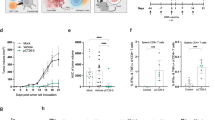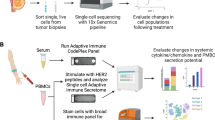Abstract
The potency of DNA vaccines may be affected by the efficiency of intracellular processing and MHC class I presentation of encoded antigens. Since a single-chain trimer (SCT) composed of peptide, β2-microglobulin (β2m), and MHC class I heavy chain has been shown to bypass antigen processing and lead to stable presentation of peptides, we investigated the efficacy of a DNA vaccine encoding a SCT composed of an immunodominant CTL epitope of human papillomavirus type 16 (HPV-16) E6 antigen, β2m, and H-2Kb MHC class I heavy chain (pIRES-E6-β2m-Kb). Transfection of 293 cells with pIRES-E6-β2m-Kb can bypass antigen processing and lead to stable presentation of E6 peptide. Furthermore, C57BL/6 mice vaccinated with pIRES-E6-β2m-Kb exhibited significantly increased E6 peptide-specific CD8+ T-cell immune responses compared to mice vaccinated with DNA encoding wild-type E6. Most importantly, 100% of mice vaccinated with pIRES-E6-β2m-Kb DNA were protected against a lethal challenge of E6-expressing TC-1 tumor cells. In contrast, all mice vaccinated with wild-type E6 DNA or control plasmid DNA grew tumors. Our data indicate that a DNA vaccine encoding a SCT can lead to stable enhanced MHC class I presentation of encoded antigenic peptide and may be useful for improving DNA vaccine potency to control tumors or infectious diseases.
This is a preview of subscription content, access via your institution
Access options
Subscribe to this journal
Receive 12 print issues and online access
$259.00 per year
only $21.58 per issue
Buy this article
- Purchase on Springer Link
- Instant access to full article PDF
Prices may be subject to local taxes which are calculated during checkout






Similar content being viewed by others
References
Boyd D, Hung CF, Wu TC . DNA vaccines for cancer. IDrugs 2003; 6: 1155–1164.
Donnelly JJ, Ulmer JB, Shiver JW, Liu MA . DNA vaccines. Annu Rev Immunol 1997; 15: 617–648.
Gurunathan S, Klinman DM, Seder RA . DNA vaccines: immunology, application, and optimization*. Annu Rev Immunol 2000; 18: 927–974.
Hung CF, Wu TC . Improving DNA vaccine potency via modification of professional antigen presenting cells. Curr Opin Mol Ther 2003; 5: 20–24.
Pamer E, Cresswell P . Mechanisms of MHC class I-restricted antigen processing. Annu Rev Immunol 1998; 16: 323–358.
Mottez E et al. Cells expressing a major histocompatibility complex class I molecule with a single covalently bound peptide are highly immunogenic. J Exp Med 1995; 181: 493–502.
Uger RA, Barber BH . Creating CTL targets with epitope-linked beta 2-microglobulin constructs. J Immunol 1998; 160: 1598–1605.
Yu YY et al. Cutting edge: single-chain trimers of MHC class I molecules form stable structures that potently stimulate antigen-specific T cells and B cells. J Immunol 2002; 168: 3145–3149.
Lin K-Y et al. Treatment of established tumors with a novel vaccine that enhances major histocompatibility class II presentation of tumor antigen. Cancer Res 1996; 56: 21–26.
zur Hausen H . Papillomaviruses and cancer: from basic studies to clinical application. Nat Rev Cancer 2002; 2: 342–350.
Peng S et al. Development of a DNA vaccine targeting HPV-16 oncogenic protein E6. J. Virol. 2004; 78: 8468–8476.
Ji H et al. Antigen-specific immunotherapy for murine lung metastatic tumors expressing human papillomavirus type 16 E7 oncoprotein. Int J Cancer 1998; 78: 41–45.
Porgador A et al. Predominant role for directly transfected dendritic cells in antigen presentation to CD8+ T cells after gene gun immunization. J Exp Med 1998; 188: 1075–1082.
Kim TW et al. Enhancing DNA vaccine potency by coadministration of DNA encoding antiapoptotic proteins. J Clin Invest 2003; 112: 109–117.
Kim TW et al. Enhancing DNA vaccine potency by combining a strategy to prolong dendritic cell life with intracellular targeting strategies. J Immunol 2003; 171: 2970–2976.
Chung DH et al. NK and CTL recognition of a single chain H-2Dd molecule: distinct sites of H-2Dd interact with NK and TCR. J Immunol 1999; 163: 3699–3708.
Lee L et al. Functional cell surface expression by a recombinant single-chain class I major histocompatibility complex molecule with a cis-active beta 2-microglobulin domain. Eur J Immunol 1994; 24: 2633–2639.
Lone YC et al. In vitro induction of specific cytotoxic T lymphocytes using recombinant single-chain MHC class I/peptide complexes. J Immunother 1998; 21: 283–294.
Lybarger L et al. Enhanced immune presentation of a single-chain major histocompatibility complex class I molecule engineered to optimize linkage of a C-terminally extended peptide. J Biol Chem 2003; 278: 27105–27111.
Anjuere F, Horvath C, Cerottini JC, Luescher IF . Induction of CTL in vivo by major histocompatibility complex class I–peptide complexes covalently associated on the cell surface. Eur J Immunol 1995; 25: 1535–1540.
Greten TF et al. Peptide–beta2-microglobulin–MHC fusion molecules bind antigen-specific T cells and can be used for multivalent MHC–Ig complexes. J Immunol Methods 2002; 271: 125–135.
Slansky JE et al. Enhanced antigen-specific antitumor immunity with altered peptide ligands that stabilize the MHC–peptide–TCR complex. Immunity 2000; 13: 529–538.
Chen C-H et al. Enhancement of DNA vaccine potency by linkage of antigen gene to an HSP70 gene. Cancer Res 2000; 60: 1035–1042.
Acknowledgements
We thank Dr Richard Roden for helpful discussions. We would also like to thank Drs Ralph Hruban and Ken-Yu Lin for critical review of this paper. This work was supported by grants from the National Institute of Allergy and Infectious Disease, the National Cancer Institute, and the American Cancer Society.
Author information
Authors and Affiliations
Rights and permissions
About this article
Cite this article
Huang, CH., Peng, S., He, L. et al. Cancer immunotherapy using a DNA vaccine encoding a single-chain trimer of MHC class I linked to an HPV-16 E6 immunodominant CTL epitope. Gene Ther 12, 1180–1186 (2005). https://doi.org/10.1038/sj.gt.3302519
Received:
Accepted:
Published:
Issue Date:
DOI: https://doi.org/10.1038/sj.gt.3302519
Keywords
This article is cited by
-
Identification of the murine H-2Db and human HLA-A*0201 MHC class I-restricted HPV6 E7-specific cytotoxic T lymphocyte epitopes
Cancer Immunology, Immunotherapy (2016)
-
Introduction of a point mutation into an HLA class I single-chain trimer induces enhancement of CTL priming and antitumor immunity
Molecular Therapy - Methods & Clinical Development (2014)
-
A synthetic chimeric peptide harboring human papillomavirus 16 cytotoxic T lymphocyte epitopes shows therapeutic potential in a murine model of cervical cancer
Immunologic Research (2014)
-
Therapeutic HPV DNA vaccines
Immunologic Research (2010)
-
Activation of Akt as a Mechanism for Tumor Immune Evasion
Molecular Therapy (2009)



